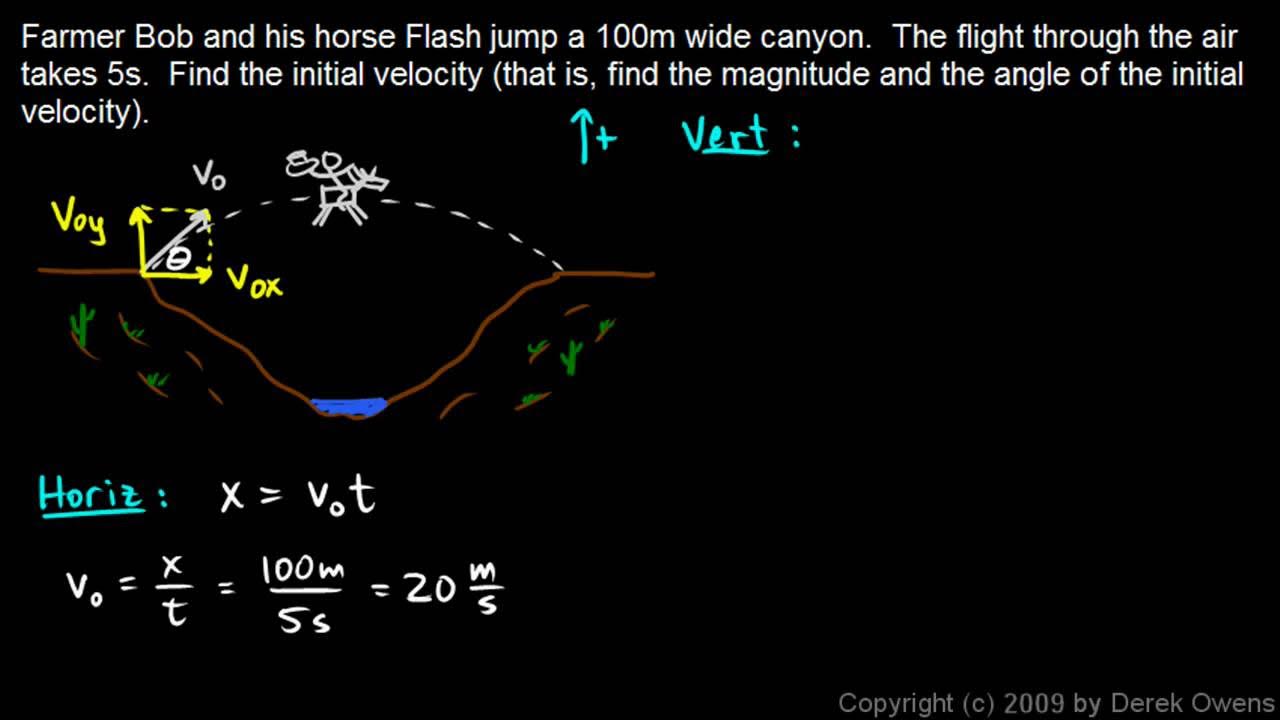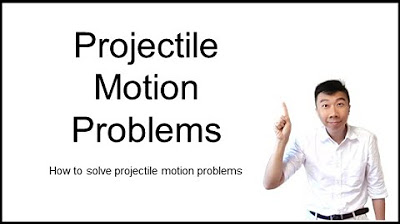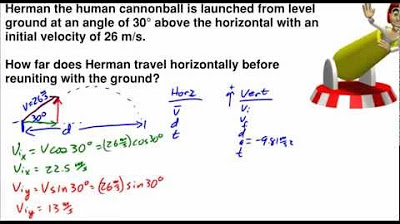AP Physics B Kinematics Presentation General Problems #11
TLDRThis script explains the physics of a baseball hit at an initial velocity of 50 m/s at a 30° angle. It calculates the maximum height reached using the vertical component of the velocity and gravity, determining it to be 32 meters. It also finds the total time in the air to be 5.1 seconds by considering the symmetry of the projectile's motion. The horizontal range is calculated to be 221 meters, using the horizontal component of the velocity and time. Finally, the script determines the velocity of the projectile 5 seconds after launch to be 49 m/s, using the Pythagorean theorem to combine the horizontal and vertical components of velocity.
Takeaways
- 🏀 The initial speed of the baseball is 50 m/s, launched at a 30° angle above the horizontal.
- 📉 The vertical acceleration of the projectile is due to gravity, which is -9.8 m/s², indicating a downward force.
- 🚀 The horizontal acceleration is 0 m/s², as there is no force acting to change the horizontal velocity.
- 📈 The maximum height formula used is \( \Delta Y = \frac{V_{y_{\text{Apex}}}^2 - V_{y}^2}{2a_y} \), where \( V_{y_{\text{Apex}}} \) is the vertical velocity at the highest point (0 m/s).
- 🌟 The calculated maximum height of the projectile is 32 meters.
- ⏱ Two methods are discussed for determining the total time in the air: using the landing equation and the symmetry of the projectile's motion.
- 🕒 The total time in the air is calculated to be 5.1 seconds using the vertical velocity and acceleration due to gravity.
- 📏 To find the maximum horizontal distance, the equation \( X = V_x \cdot T \) is used, resulting in a range of 221 meters.
- 🔢 The velocity components are calculated separately for horizontal (\( V_x \)) and vertical (\( V_y \)) directions.
- 🛰️ Five seconds after launch, the vertical velocity is -24 m/s, and the horizontal velocity remains 43 m/s due to no horizontal acceleration.
- 📐 The final velocity 5 seconds after launch is determined using the Pythagorean theorem, resulting in a velocity of 49 m/s.
Q & A
What is the initial velocity of the baseball hit in the script?
-The initial velocity of the baseball is 50 m/s.
At what angle is the baseball hit in relation to the horizontal?
-The baseball is hit at a 30° angle above the horizontal.
What is the acceleration due to gravity used in the script for the vertical direction?
-The acceleration due to gravity used in the script for the vertical direction is 9.8 m/s².
Why is the acceleration in the horizontal direction considered to be 0 m/s²?
-The acceleration in the horizontal direction is considered to be 0 m/s² because there is no force acting upon the object to accelerate it horizontally once it is in motion.
What is the formula used to calculate the maximum height reached by the projectile?
-The formula used to calculate the maximum height is ΔY = (Vy_apex² - Vy²) / (2 * a_y), where Vy_apex is the final vertical velocity at the apex, Vy is the initial vertical velocity, and a_y is the acceleration due to gravity.
What is the calculated maximum height reached by the projectile in the script?
-The calculated maximum height reached by the projectile is 32 meters.
How is the total time in the air for the projectile determined in the script?
-The total time in the air is determined using the equation T = (Vy_final - Vy_initial) / a_y, where Vy_final is the final vertical velocity, Vy_initial is the initial vertical velocity, and a_y is the acceleration due to gravity.
What is the total time in the air for the projectile as calculated in the script?
-The total time in the air for the projectile is calculated to be 5.1 seconds.
How is the maximum horizontal distance covered by the projectile calculated?
-The maximum horizontal distance is calculated using the equation X = VX * T, where VX is the horizontal velocity component and T is the total time in the air.
What is the maximum horizontal distance covered by the projectile according to the script?
-The maximum horizontal distance covered by the projectile is 221 meters.
How is the velocity of the projectile 5 seconds after it was fired calculated in the script?
-The velocity 5 seconds after firing is calculated by determining the vertical (Vy) and horizontal (VX) components of the velocity at that time and then using the Pythagorean theorem to find the resultant velocity (V).
What is the velocity of the projectile 5 seconds after it was fired as per the script?
-The velocity of the projectile 5 seconds after it was fired is 49 m/s.
Outlines
🚀 Projectile Motion Analysis
This paragraph discusses the physics of a baseball hit at an angle, focusing on the maximum height reached by the projectile. The initial velocity is given as 50 m/s at a 30° angle above the horizontal. The acceleration due to gravity is considered, and the horizontal acceleration is zero due to no external forces. The starting position for both x and y coordinates is set at 0 m. The formula used to calculate the height is derived from the kinematic equation, and the height is found to be 32 meters. The paragraph also explains two methods to determine the total time in the air, opting for the second method which uses the initial and final vertical velocities to find a time of 5.1 seconds.
⏱ Calculating Time and Horizontal Range
The second paragraph delves into calculating the total time the projectile spends in the air and the maximum horizontal distance it covers. It describes the process of using the kinematic equation to find the time it takes for the object to land, given the initial and final heights are both 0 m. The paragraph then simplifies the calculation by using the initial and final vertical velocities, resulting in a time of 5.1 seconds. To determine the horizontal range, the equation x = vx * T is used, with vx being the horizontal component of the initial velocity and T the total time in the air, yielding a range of 221 meters.
📏 Velocity Calculation Post-Launch
The final paragraph addresses the calculation of the projectile's velocity 5 seconds after it was launched. It explains the need to determine both the vertical (VY) and horizontal (VX) components of the velocity at this time. The vertical velocity is calculated using the initial vertical velocity, the acceleration due to gravity, and the time elapsed. The horizontal velocity remains constant due to the absence of horizontal acceleration. Using the Pythagorean theorem, the resultant velocity is found by combining the vertical and horizontal components, resulting in a velocity of 49 m/s at the specified time.
Mindmap
Keywords
💡Projectile Motion
💡Initial Velocity
💡Angle of Projection
💡Acceleration Due to Gravity
💡Horizontal Component
💡Vertical Component
💡Apex
💡Equation of Motion
💡Horizontal Range
💡Time in the Air
💡Velocity Vector
Highlights
Initial velocity of 50 m/s at a 30° angle above the horizontal for the baseball hit.
Vertical acceleration equals acceleration due to gravity, 9.8 m/s².
Horizontal acceleration is 0 m/s² as there is no force acting on the object.
At the highest point, the vertical component of velocity (Vy) is 0 m/s.
Equation used to calculate height: ΔY = Vy² - Vy₀² / 2ay.
Height of the projectile calculated to be 32 meters.
Two methods to determine total time in the air for the projectile.
Total time in the air calculated to be 5.1 seconds using the second method.
Horizontal range equation: x = vx * T, with no horizontal acceleration.
Maximum horizontal distance covered by the projectile is 221 meters.
Calculating the velocity of the projectile 5 seconds after launch involves determining Vy and vx.
Vy is calculated using the initial vertical velocity component and gravity.
Vx remains constant at 43 m/s due to no horizontal acceleration.
Resultant velocity after 5 seconds calculated using the Pythagorean theorem.
Velocity of the projectile 5 seconds after launch is 49 m/s.
Transcripts
5.0 / 5 (0 votes)
Thanks for rating:





